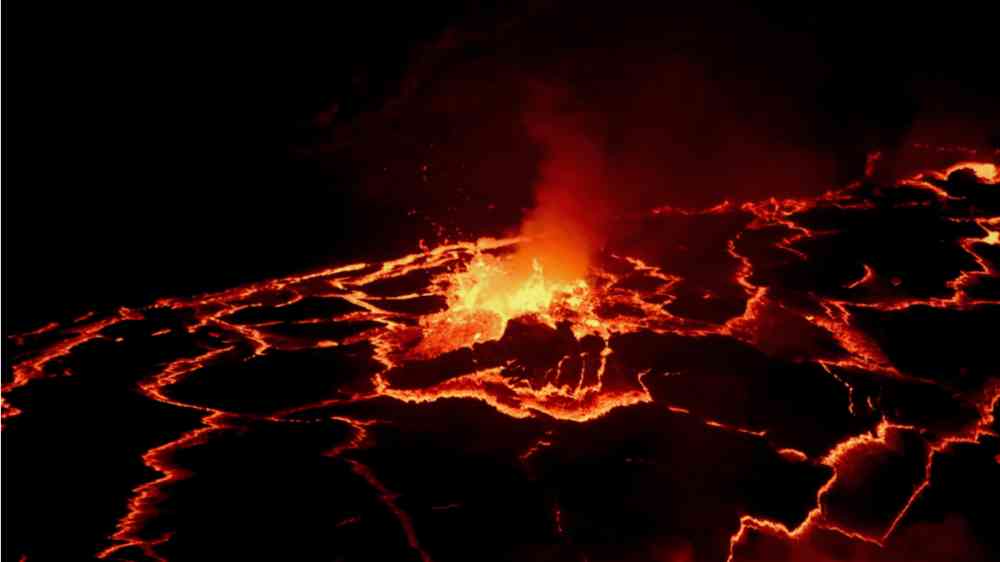Raising hazard awareness at the foot of one of the world’s most dangerous volcanoes

In the shadow of a deadly eruption in 2021, students in Goma, Democratic Republic of the Congo, are learning about future hazards.
Memories of the glow emanating from the top of Congo’s Mount Nyiragongo volcano have not been forgotten by those living nearby. At the volcano’s summit is a lava lake that lights up the night sky like a beacon. In May 2021, an unexpected lava flow came down Nyiragongo’s flank, pouring into the outskirts of the nearby city of Goma in the Democratic Republic of the Congo as residents fled in the dark.
“Volcanic eruptions cannot be prevented, so mitigation strategies are needed to reduce impact.”
Now, researchers are studying ways of educating residents about the hazards of living near one of the world’s most dangerous volcanoes. The scientists presented their research at the European Geosciences Union General Assembly 2023.
As a child in Goma, Blaise Mafuko Nyandwi grew up with the towering Nyiragongo as a backdrop and watched the red glow of its lava every night. A volcanologist at the University of Goma, he knows from experience that people living in the city still do not know how volcanoes work and may therefore be unprepared to react during future eruptions.
“Volcanic eruptions cannot be prevented, so mitigation strategies are needed to reduce impact,” said Mafuko, lead researcher of the new study. Mitigation can mean making the nearby population aware and ready to react, he added.
With the ever present threat in the region, situated in the Virunga Volcanic Province of East Africa, Mafuko and his colleagues worked with 435 sixteen-year-old students from 12 high schools in Goma to test how well two extracurricular activities raised awareness of geological risk: playing the Hazagora board game and visiting the Virunga Volcano Museum.
Gaming and Exploring the Way to Awareness
On the fictional island of Hazagora, players develop a society regularly hit by earthquakes, volcanic eruptions, floods, and landslides. Five to 10 players, representing the island’s mayor, a fisherman, a lumberjack, a farmer, and a tour guide, must figure out how to survive disasters by making trade-offs on protective measures. Players use their annual income to provide for their family’s basic needs but can also stockpile supplies and reinforce or protect infrastructure, for instance.
The game, originally developed by researchers at Vrije Universiteit Brussel, includes information sheets on geological hazards that the moderator can use to reinforce the players’ knowledge. Through discussions about the events and possible consequences, players learn more about the natural processes at work and how to reduce risk.
“The information on volcanic risk that makes Hazagora valuable is broad,” Mafuko explained. The game could symbolize any volcanic region.
On the other hand, the Virunga Volcano Museum, which recently opened next to the Goma Volcano Observatory (GVO), features informative panels and documentaries about volcanic hazards, monitoring activities conducted at GVO, historical eruptions of Nyiragongo, and what to do during an eruption. In the center of the room is an animated 3D model of the Virunga volcanic chain.
“At the museum, students learned about Nyiragongo’s historic eruptions. The exhibit reinforces knowledge of volcanoes, and Virunga volcanoes specifically,” Mafuko said. “The students were introduced to volcanologists and monitoring equipment and read about volcano preparedness and mitigation measures for risks.”
Museums are useful because they help take the students out of their normal learning environment and provide good samples and tools and, often, expertise to help the students connect the dots on the topic, said Carina Fearnley, director of University College London’s Warning Research Centre, who was not involved in the study.
Through surveys and conversations, the researchers found that both the game and the museum reinforced students’ knowledge of volcanism, but the museum was a more effective tool to help students learn about how volcanoes work. The Hazagora game, on the other hand, made the students more knowledgeable about how to take protective action.
This study provided valuable insight into the success of a paired approach to learning about volcanoes, using a range of tools and types of engagement, Fearnley added.
Striking Motivation
Mafuko said he was struck by the students’ initial low level of understanding about volcanic processes and risk despite them living at the foot of the volcano. He and his colleagues did find, however, that the students were motivated to learn more and were willing to engage in disaster risk reduction activities in their school communities and with their families, Mafuko said.
“These students are the future decisionmakers and stakeholders in disaster risk reduction,” said Joseph Makundi, Goma’s civil protection coordinator. “They are powerful in influencing members of their community to adopt protective behavior.” Reaching students is therefore key to building a prepared community in Goma.
“Goma is a particularly vulnerable population for volcanic hazards, and any work that can be done to build awareness and resilience is vital.”
The work “highlights the importance of teaching hazard and risk management at schools, not just in Goma,” Fearnley said. “Goma is a particularly vulnerable population for volcanic hazards, and any work that can be done to build awareness and resilience is vital.”
Academics, risk managers, and teachers should work together to design attractive educational actions specific for their context, Mafuko suggested.
These kinds of simple educational activities may be more practical for teaching, especially in the Global South, where advanced technologies such as augmented virtual reality, which is sometimes used to raise hazard awareness, are difficult to implement. Policymakers should integrate disaster resilience into school curriculums and recommend extracurricular activities in which students can be active learners, Mafuko said.